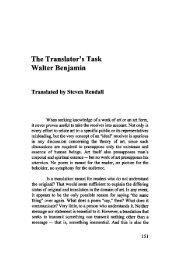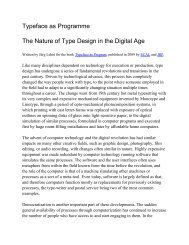Konstnären och kulturnäringarna Artists and the Arts Industries
Konstnären och kulturnäringarna Artists and the Arts Industries
Konstnären och kulturnäringarna Artists and the Arts Industries
You also want an ePaper? Increase the reach of your titles
YUMPU automatically turns print PDFs into web optimized ePapers that Google loves.
Yudhishthir Raj Isar | Problems with <strong>the</strong> Paradigm Yudhishthir Raj Isar | Problems with <strong>the</strong> Paradigm<br />
market or taken over by <strong>the</strong> ever-growing transnational corporations.<br />
For Throsby (2008: 33), ‘<strong>the</strong> crisis of value engendered<br />
by <strong>the</strong>se trends is clear: music production in <strong>the</strong>se circumstances<br />
becomes increasingly a process of creating economic value<br />
ra<strong>the</strong>r than a cultural expression whose primary importance is<br />
as a purveyor of cultural meaning.’ It is difficult to escape <strong>the</strong><br />
conclusion that <strong>the</strong>re is steadily increasing emphasis on <strong>the</strong> economic<br />
value of cultural production, a trend that may be accepted<br />
willingly by some producers, <strong>and</strong> reluctantly <strong>and</strong> inevitably by<br />
o<strong>the</strong>rs. The technological impacts also have a range of effects,<br />
from <strong>the</strong> undoubted benefits of new media for artistic creativity<br />
to <strong>the</strong> more uncertain effects on <strong>the</strong> interpretation of cultural<br />
value in <strong>the</strong> new technological utopia. Yet, as Stuart Hall (2004:<br />
34) warns us, we must not overplay <strong>the</strong> beneficial effects of globalization<br />
on artistic production, for:<br />
One of <strong>the</strong> immediate effects of globalization has been <strong>the</strong> in-<br />
ternationalization of <strong>the</strong> circuits <strong>and</strong> circulations of cultural<br />
<strong>and</strong> artistic production . . . it’s now ideologically represented<br />
to us as if <strong>the</strong>re’s a frictionless cultural universe in which any-<br />
body can get on <strong>the</strong> tramline anywhere, any work of art will be<br />
seen anywhere . . . [But] in reality . . . you see massive dispari-<br />
ties of access, of visibility, huge yawning gaps between who can<br />
<strong>and</strong> who can’t be represented in an effective way.<br />
Economics isn’t everything...<br />
My initial questioning of <strong>the</strong> primacy accorded to creative industries<br />
reasoning stems from an abiding sympathy for <strong>the</strong> ‘arts<br />
for arts’ sake’ school of thought. In o<strong>the</strong>r words, I start with a<br />
belief in <strong>the</strong> intrinsic value of <strong>the</strong> arts, a stance that has little<br />
purchase among most analysts of cultural policy issues nowadays,<br />
<strong>and</strong> indeed is seen by many as ‘old-fashioned obfuscation,<br />
<strong>and</strong> just not hard-headed enough’ (Holden, 2002: 22).<br />
This belief of mine is not just soft-headed, however, for as <strong>the</strong><br />
experience of decades of economic <strong>and</strong> social impact studies<br />
of <strong>the</strong> arts clearly shows, <strong>the</strong> problem is not just that much of<br />
<strong>the</strong> case made for that economic impact is overstated as a result<br />
of special pleading, but also that <strong>the</strong> performance of <strong>the</strong><br />
arts sector is easily exceeded by o<strong>the</strong>r sectors of <strong>the</strong> economy<br />
in terms of <strong>the</strong>ir contribution to <strong>the</strong> economy. Never<strong>the</strong>less,<br />
it would be difficult to find a cultural politician or official<br />
anywhere who would talk or act on <strong>the</strong> basis of intrinsic value<br />
arguments. A notable exception is <strong>the</strong> cultural manager <strong>and</strong><br />
writer John Tusa, who in 1999 first aired <strong>the</strong> view that <strong>the</strong><br />
arts matter not for <strong>the</strong> instrumental reasons – in o<strong>the</strong>r words<br />
not for <strong>the</strong> potential contribution to <strong>the</strong> economy, etc. – but<br />
for <strong>the</strong>ir aes<strong>the</strong>tic value <strong>and</strong> everything that accompanies it.<br />
In reality, however, <strong>and</strong> across <strong>the</strong> entire spectrum of political<br />
systems today, ‘<strong>the</strong> search for at least alternative, if not actually<br />
superior, justifications for <strong>the</strong> creation of cultural <strong>and</strong><br />
artistic policies has led to an increasing ‘attachment’ of arts<br />
<strong>and</strong> cultural policies to o<strong>the</strong>r sets of policy concerns in a quite<br />
clearly instrumental fashion’ (Gray, 2007: 203). This instrumentalization<br />
has many different consequences; among <strong>the</strong>m<br />
is a different kind of relationship between states <strong>and</strong> <strong>the</strong>ir<br />
citizens. Tusa himself, revisiting in 2005 his purist stance of<br />
1999, was ready to admit that<br />
The arts do stimulate <strong>the</strong> growth of a creative sector in <strong>the</strong><br />
economy. They do play a part in <strong>the</strong> vigour of <strong>the</strong> ideas eco-<br />
nomy. Yet, true as this is, it still seems to me to miss <strong>the</strong><br />
point. The value of <strong>the</strong> arts is not to be defined as if <strong>the</strong>y<br />
were just ano<strong>the</strong>r economic lever to be pulled. That would<br />
place <strong>the</strong>m on a level of activity where measurement of re-<br />
sults, predictability of outcome <strong>and</strong> direction of activity are<br />
rated as conditions of success <strong>and</strong> <strong>the</strong>refore as grounds for<br />
investment in <strong>the</strong> first place. It puts us back in <strong>the</strong> bind of<br />
instrumentality. The real question, <strong>the</strong>n, is this: if art cannot<br />
repay <strong>the</strong> public subsidy; if it represents an investment on<br />
which <strong>the</strong>re is no return; if it cannot guarantee audiences; if<br />
it cannot demonstrate immediate social relevance - if all of<br />
this is <strong>the</strong> case, why does art matter? Real art can fail every<br />
measurable objective set by economists <strong>and</strong> politicians. Yet<br />
it will still be art, sometimes great art. The criteria by which<br />
it is judged are different <strong>and</strong> must be appropriate to <strong>the</strong> ac-<br />
tivity. This is not to evade accountability; it is to insist that<br />
accountability must be right for <strong>the</strong> activity.<br />
Although for <strong>the</strong> John Tusas of this world <strong>the</strong> terrain of <strong>the</strong><br />
political might simply represent just ano<strong>the</strong>r form of instrumentality<br />
– <strong>and</strong> not offer in <strong>the</strong>ir eyes <strong>the</strong> kind of accountability<br />
that is right for artistic activity – I contend that <strong>the</strong>re are<br />
concerns of a political nature, questions of political philosophy,<br />
that should be given as much importance as <strong>the</strong> claims of market<br />
viability or profitability. One such claim is that of democracy<br />
itself, which needs <strong>the</strong> arts (<strong>and</strong> <strong>the</strong> humanities which<br />
<strong>the</strong>y anchor) as crucial elements in driving <strong>and</strong> energizing civil<br />
society. I would follow <strong>the</strong> American political scientist Benjamin<br />
Barber here, when he asserts that (1997: 1) ‘a free society<br />
gains its liberty <strong>and</strong> its democratic vitality from civil society,<br />
<strong>and</strong> <strong>the</strong> arts <strong>and</strong> humanities invest civil society with its creativity,<br />
its diverseness <strong>and</strong> its liberating spontaneity.’ As Barber<br />
also observes, what complicates <strong>the</strong> relationship is <strong>the</strong> market,<br />
with which civil society is now almost always conflated in our<br />
neo-liberal systems of governance. To be sure, <strong>the</strong> market offers<br />
free <strong>and</strong> private space to art <strong>and</strong> culture <strong>and</strong> thus insulates<br />
<strong>the</strong>m from official governmental direction <strong>and</strong> censorship;<br />
yet <strong>the</strong> commercial space can imperil artistic autonomy as<br />
well. <strong>Artists</strong> may be invisibly coerced more strenuously by <strong>the</strong><br />
constraints of <strong>the</strong> marketplace today than by any o<strong>the</strong>r force,<br />
subjected to <strong>the</strong> dynamics of commerce that pushes towards<br />
uniformity of taste, a levelling of st<strong>and</strong>ards, <strong>and</strong> <strong>the</strong> commodification<br />
of art products. <strong>Artists</strong> in turn, although <strong>the</strong>y may<br />
certainly choose to pursue <strong>the</strong>ir muse free from interference,<br />
may discover that by assuming public responsibilities, say for<br />
arts education <strong>and</strong> civic engagement, <strong>the</strong>y contribute to a climate<br />
that is as tolerant <strong>and</strong> pluralistic as liberal philosophy<br />
says it ought to be. <strong>Artists</strong> may be responsible only to <strong>the</strong>ir<br />
art, but <strong>the</strong>y are also citizens, <strong>and</strong> as citizens <strong>the</strong>y contribute<br />
to <strong>and</strong> nourish an arts-supportive civil society. In doing so <strong>the</strong>y<br />
at once serve democracy <strong>and</strong> <strong>the</strong>mselves, <strong>the</strong>ir fellow citizens<br />
<strong>and</strong> <strong>the</strong>ir art. As Barber puts it (1997: 11-12),<br />
As democracy depends on civil society for its liberal spirited-<br />
ness, so civil society depends on <strong>the</strong> arts. Democracy ultima-<br />
tely rests on <strong>the</strong> arts’ commitment to free creativity, liberal<br />
36 37









